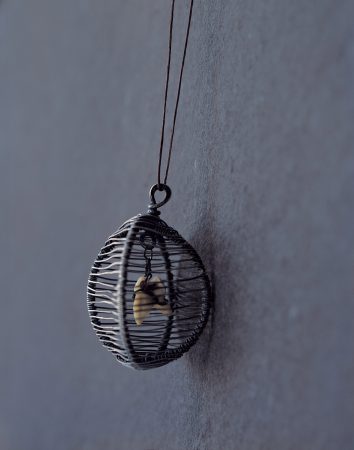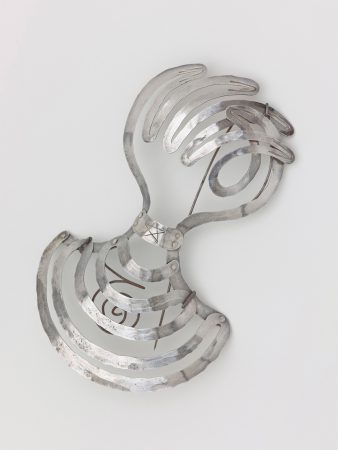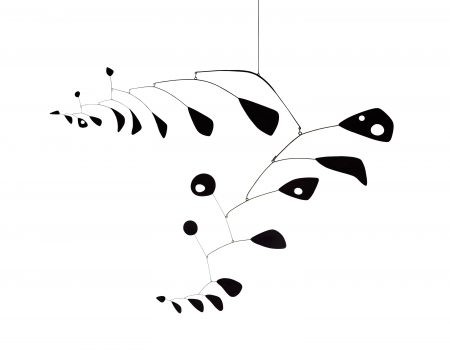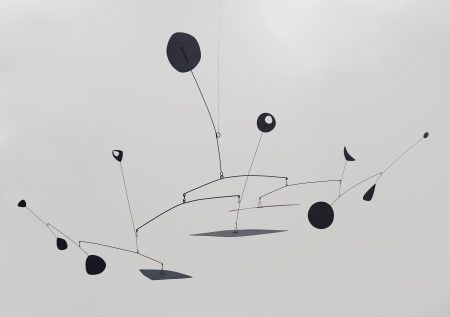Archive
Calder rebuilds the “Big Room” in his Roxbury house. We are rebuilding the room which burned four years ago (where we sat last time you were here). Over the next year, Calder raises the roof about five feet and installs steel sash windows in the southeast wall.
CF, Calder to Warner, 13 December
“Alexander Calder” is on view at Buchholz Gallery/Curt Valentin, New York.
CF, exhibition file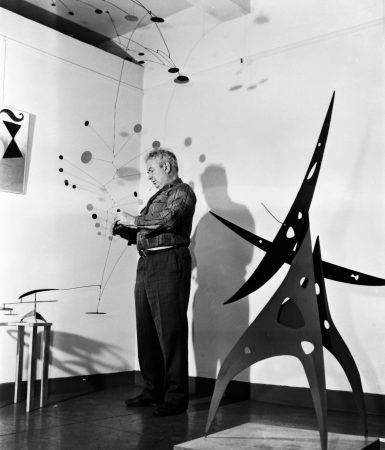
Calder’s daughter Mary has a painful molar extracted on Christmas Day. Calder takes the tooth and memorializes it in a silver wire, caged pendant, which he gives to her for Christmas.
ASCR conversation with Mary Calder Rower, 8 August 20071948
Quadrangle Press publishes Selected Fables with etchings by Calder. Jean de La Fontaine is editor.
CF, object fileCalder exhibits his work at the Institute of Contemporary Arts, Washington, D.C.
Lipman 1976, 334Calder meets Burgess Meredith, who later visits the Calders in Roxbury to discuss making a film about Calder and his mobiles. Calder suggests Matter as the cinematographer.
Calder 1966, 197Calder accepts Mindlin’s invitation to visit Brazil.
Calder 1966, 199For the XXIV Biennale di Venezia—the first Biennale of the postwar period—Calder’s Arc of Petals is included in a presentation of Peggy Guggenheim’s collection curated by art historian Giulio Carlo Argan.
CF, exhibition fileThe Calders drive to the Grand Canyon, Death Valley, Reno, and Lake Tahoe, where they spend two weeks with Kenneth and Peggy Hayes. After driving to Berkeley, they leave Sandra and Mary with the Hayes family, and fly to Los Angeles.
Calder 1966, 198–99; ASCR conversation with Mary Calder Rower, 23 October 1997Louisa’s mother, Louisa Cushing James, dies.
Calder 1966, 255Calder and Louisa arrive in Mexico City, where they stay at the Hotel Prince. They visit with Fernando Gamboa, director of the Museo de Bellas Artes, and with filmmaker Luis Buñuel and his family.
Calder 1966, 198–99Calder and Louisa arrive in Panama. I insisted on taking Louisa in a taxi to Panama City, to see the crazy traffic and open buildings I had seen sixteen years before, when a fireman on the S.S. Alexander.
Calder 1966, 198–99Calder and Louisa arrive in Trinidad.
Calder 1966, 198–99; CF, passportFrom Trinidad, the Calders fly to Belém, Brazil. On the plane they meet writer John Dos Passos.
CF, passport; Calder 1966, 199Calder and Louisa arrive in Rio de Janeiro.
CF, passportThe Ministerio da Educaçao e Saude presents “Alexander Calder.” The catalogue includes “Les Mobiles de Calder” by Sartre, “Alexander Calder” by Mindlin, and statements by Breton, Nancy Cunard, and Sweeney.
CF, exhibition file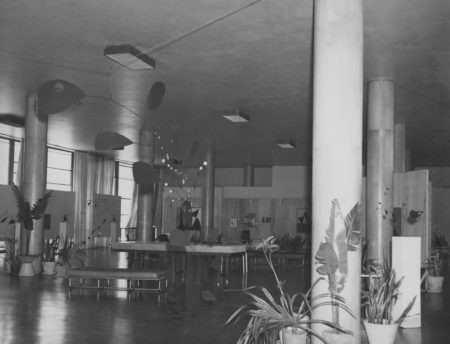
Museu de Arte, São Paulo, Brazil, presents “Alexander Calder.”
CF, exhibition fileThe Calders throw a farewell party before departing Rio de Janeiro. Calder improvises decorations and hangs them on the wall. Heitor Dos Praceres (Hector of the Pleasures), a Negro painter and friend of ours, had an excellent samba band, so we decided that they should come sixteen strong …The party took place
in the little house where I worked. Two days before, Lota wrote to Eugenio [Lage] in New York, saying that if he did not see any objection we would have a party there.
The Calders embark from Rio de Janeiro for the United States.
CF, passportIn Berkeley, Calder and Louisa are reunited with their children. The family spends a week with the Hayes family before driving back across country with side trips to Sante Fe, New Mexico, and Texas.
Calder 1966, 204; CF, passport; ASCR conversation with Mary Calder Rower, 23 October 1997Buchholz Gallery/Curt Valentin, New York, presents “Alexander Calder Recent Mobiles, 1948.”
CF, exhibition fileCalder exhibits a work on paper in “A Comparison of Primitive and Modern: 40,000 Years of Modern Art” at the Institute of Contemporary Arts, London.
CF, exhibition file1949
Calder creates mobiles for Symphonic Variations, choreographed by Tatiana Leskova with music by César Franck. The dance is performed in Rio de Janeiro.
CF, object fileMuseu de Arte Moderna, São Paulo, presents “Do Figurativismo ao Abstracionismo” and includes five works by Calder.
CF, exhibition fileUpon returning home from Brazil, Calder crafts a large brooch for Henrique Mindlin’s wife, Helena. The brooch is in the form of a figa—a hand with the thumb curled under the forefinger—a symbol of luck in Brazil. Thank you, thank you, thank you ever so much for the most beautiful figa I have ever
seen. You managed to make many females terribly envious of me, and this makes me oh! so happy! Calder eventually makes at least twenty pieces of jewelry in the figa motif, nearly all as gifts for family and friends.
Calder constructs his most ambitious mobile to date, International Mobile, for the Third International Exhibition of Sculpture, Philadelphia Museum of Art in collaboration with the Fairmount Park Art Association.
CF, exhibition file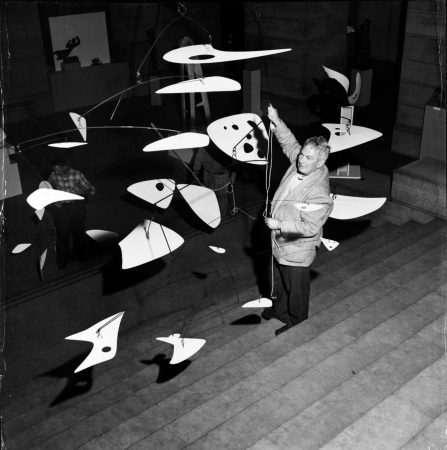
Calder builds a house for his mother on the Roxbury property.
CF, photography file; CF, Nanette to Calder, 6 May
“Calder” is presented at the Margaret Brown Gallery, Boston.
CF, exhibition file
The Virginia Museum of Fine Arts, Richmond, presents “Calder & Sculpture Today,” with works by Jean Arp, Alexander Archipenko, Constantin Brancusi, Calder, and Alberto Giacometti, among others.
CF, exhibition fileBuchholz Gallery/Curt Valentin, New York, exhibits “Calder.” The catalogue includes “The Studio of Alexander Calder” by Masson and illustrations by Calder of the objects exhibited.
CF, exhibition file1950
Happy As Larry, a play written by Donagh MacDonagh and directed by Burgess Meredith with sets by Calder, opens in New York at the Coronet Theatre.
CF, project fileThe Calder family sails from New York on the Ile de France and arrives in Le Havre.
CF, passport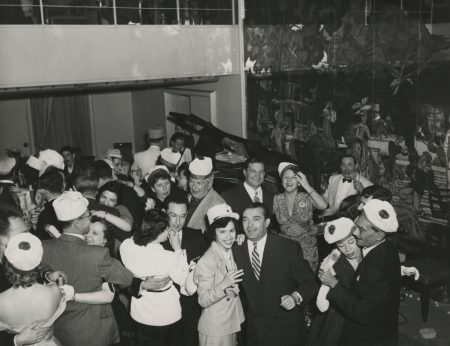
In Paris, the Calders rent an apartment for four months on rue Penthièvre from their friend, Médé Valentine.
CF, passport; Calder 1966, 204; CF, Calder to Warner, 5 FebruaryGalerie Maeght, Paris, exhibits “Calder: Mobiles & Stabiles.” Calder, encouraged by Christian Zervos (publisher of Cahiers d’Art) to exhibit at Galerie Maeght, also illustrates the catalogue and the exhibition poster. The Nationalmuseum, Stockholm, purchases a mobile
and the Musée National d’Art Moderne, Paris, purchases Le 31 Janvier.
The Calders travel around France visiting the caves of Lascaux, and Ritou Nitzschke and André Bac in La Roche Jaune, Brittany.
Calder 1966, 206; Lipman 1976, 334The Calders leave Paris and take a train to Antwerp. From there, the family takes a Finnish ship Arcturus to Helsinki.
CF, passportThe Calders visit Maire Gullichsen, who takes them to her villa, Mairea, in Norrmark for a week. From there, one day, we took a five-hour trip to see the Bjoerkenheims, who have one of the few remaining big farms in the north of Finland.
Calder 1966, 206–207The Calders leave from Turku, Finland, and take a boat to Stockholm, arriving the next day. They stay in the Grand Hotel and visit Eric Grate, a Swedish sculptor.
CF, passport; Calder 1966, 208Departing Malmö, Sweden, the Calders take a train through Denmark and Germany, and arrive in Paris.
CF, passport; Calder 1966, 208The Calders depart Paris for Antwerp, set sail the next day on the Europa, and arrive in New York.
CF, passport; Calder 1966, 208Matter photographs Calder’s Roxbury studio and home.
CF, photography file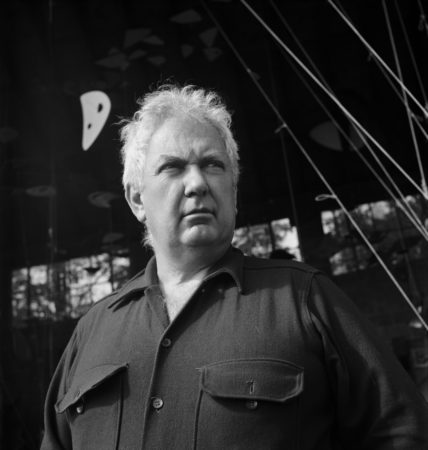
Calder is selected by the New York Times Book Review as one of the ten best children’s book illustrators of the last fifty years.
New York Times, 12 NovemberMassachusetts Institute of Technology, Cambridge, exhibits “Calder,” a retrospective. Sweeney installs the exhibition while Calder recovers from an automobile accident.
CF, exhibition file; Calder 1966, 209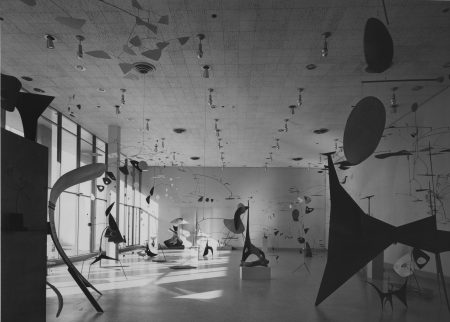
1951
After two years of production, Works of Calder previews at the Museum of Modern Art. The film was directed by Matter and produced and narrated by Burgess Meredith, with music by John Cage.
CF, project fileCalder participates in a symposium, “What Abstract Art Means to Me,” at the Museum of Modern Art in conjunction with their exhibition “Abstract Painting and Sculpture in America.” The idea of detached bodies floating in space, of different sizes and densities, perhaps of different
colors and temperatures, and surrounded and interlarded with wisps of gaseous condition, and some at rest, while others move in peculiar manners, seems to me the ideal source of form.
Calder performs Cirque Calder at the Sert’s home in Lattingtown, New York.
MS, photography collection; CF, correspondence fileInstitute of Contemporary Arts, Washington, D.C., exhibits “Sculptures by Alexander Calder.”
CF, exhibition fileIn Washington, D.C., Calder sees Jean Davidson, a friend he had first met in 1944, and invites him to visit Roxbury.
Calder 1966, 212Eero Saarinen writes to Calder proposing a commission for a sculpture and fountain at the General Motors Technical Center, Warren, Michigan. Calder suggests a fountain without any sculpture.
CF, Saarinen to Calder, 15 August; CF, Saarinen to Tykle, 28 September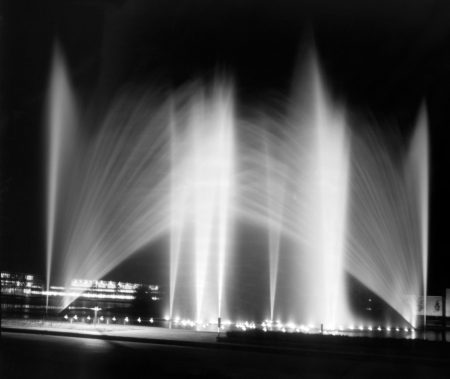
Calder presents Cirque Calder in Roxbury.
CF, correspondence fileCage’s score for Works of Calder wins first prize at the Art Film Festival in Woodstock.
CF, project fileContemporary Arts Museum, Houston, presents “Calder–Miró.”
CF, exhibition file1952
Curt Valentin Gallery, New York, exhibits “Alexander Calder: Gongs and Towers.” The catalogue texts are “Alexander Calder’s Mobiles” by Sweeney and “Calder” by Léger, with drawings by Calder of the objects exhibited.
CF, exhibition file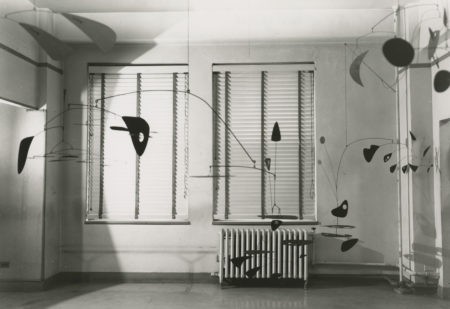
Calder arrives in Paris and stays with Paul Nelson.
CF, passport; CF, Calder and Nelson to Louisa, 19 MarchI must have met Henri Pichette at lunch with Giacometti in Paris. Now he wanted me to decorate his new play: Nucléa
Calder 1966, 209–210Calder designs the sets and costumes for Nucléa, written by Henri Pichette. The costumes include two large silver necklaces and a silver bracelet.
CF, project file; Calder 1966, 209–10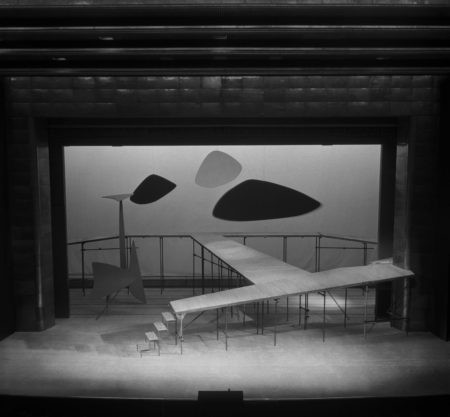
Calder and Louisa attend the opening of Nucléa at the Théâtre du Palais de Chaillot, Paris. Directed by Jean Vilar with music by Maurice Jarre, the play is performed by Théâtre National Populaire.
CF, project file; Calder 1966, 210Galerie Maeght, Paris, exhibits “Alexander Calder: Mobiles.”
CF, exhibition fileThe Calders visit Masson and his family in Aix-en-Provence. They ask Masson to find them a house to rent for the following year. From Aix-en-Provence they travel to Varengeville.
Calder 1966, 210–11; Lipman 1976, 334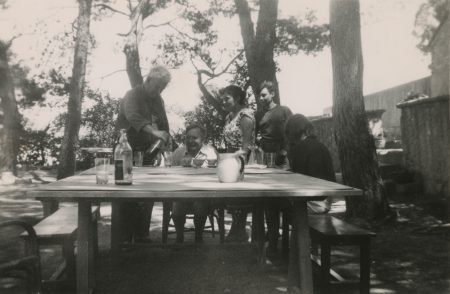
Louisa flies from Paris to New York. Calder leaves Paris on 30 May and arrives in Italy to prepare his works for the XXVI Biennale di Venezia.
CF, passportCalder returns to Paris.
CF, passportCalder flies from Paris and arrives in New York.
CF, passportCalder represents the United States in the XXVI Biennale di Venezia. Sweeney installs the exhibition and writes a short text for the exhibition catalogue. Calder wins the Grand Prize for sculpture.
CF, exhibition file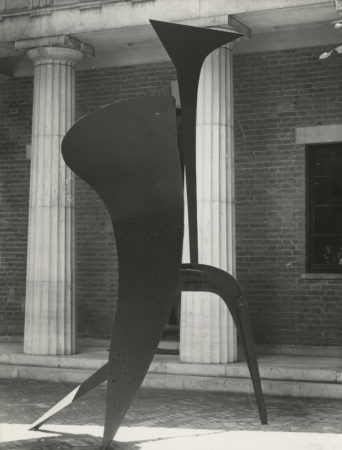
Calder accepts the commission from Carlos Raúl Villanueva, whom he met through Sert in 1951, to design an acoustic ceiling for Aula Magna, the auditorium of the Universidad Central de Venezuela. He collaborates with the engineering firm Bolt, Beranek, and Newman,
Cambridge, Massachusetts.

Moderne Galerie Otto Stangl, Munich, presents “Alexander Calder / Joan Miró.” The exhibition originated from Calder’s solo show at Galerie Parnass, Wuppertal.
CF, exhibition file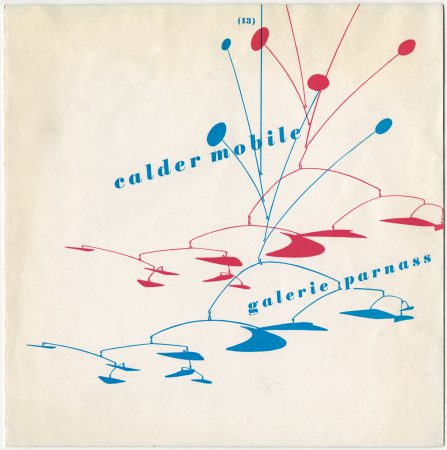
Calder performs Cirque Calder in Roxbury.
CF, Calder to Rockefeller; CF, Osborn to Calder, 8 SeptemberCalder arrives in Bonn on 10 September with an invitation from the German State Department to tour West Germany. After two days he travels to Munich, where he meets Bruno Werner, a journalist who reviewed his first Berlin exhibition in 1929. He continues on to Mannheim and
Darmstadt.
Calder stays in Berlin.
Calder 1966, 211–12Calder travels to Hamburg, where he meets the dealer Rudolf Hoffmann. He then goes on to Hanover, Bremen, and Cologne before returning to Bonn.
Calder 1966, 211–12Calder flies from Bonn to New York.
CF, passportGalerie la Hune, Paris, exhibits “Permanence du Cirque.” The exhibition commemorates the publication of a book by the same title, which includes an essay by Calder, “Voici une petite histoire de mon cirque.”
CF, exhibition fileCalder presents Cirque Calder in Washington, D.C.; Jean invites “what seemed half of Washington, D.C., to see it.”
Calder 1966, 213At the suggestion of John Cage, American composer Earle Brown travels to Roxbury to meet Calder. Pierre Boulez joins him.
CF, project file1953
Calder performs Cirque Calder in the Roxbury studio.
CF, Stillman to BreuerFrank Perls Gallery, Beverly Hills, exhibits “Alexander Calder Mobiles,” previously shown at the Walker Art Center, Minneapolis, from 22 March–19 April.
CF, exhibition fileThe Calder family arrives at Le Havre after an eight-day voyage on the Flandre. Also on board is Ernest Hemingway. He appeared suddenly and I presented myself, but it was not much use. For I had nothing to say to him and he had nothing to say to me. And that went for Louisa too.
CF, Calder to Valentin, 26 May; Calder 1966, 213The Calders arrive in the hamlet of Les Granettes in Aix-en-Provence. Their house, Mas des Roches, has little water and no electricity. Calder uses the carriage shed as his studio, where he works on gouaches. At a blacksmith shop nearby, he makes a series of large standing
mobiles conceived for the outdoors.
The Calders visit Jean Davidson in the Loire Valley. Jean has purchased a mill house Moulin Vert, in the tiny town of Saché.
Calder 1966, 219–20; CF, Calder to Peggy, 8 SeptemberCalder performs Cirque Calder at Galerie Maeght Paris.
CF, photography file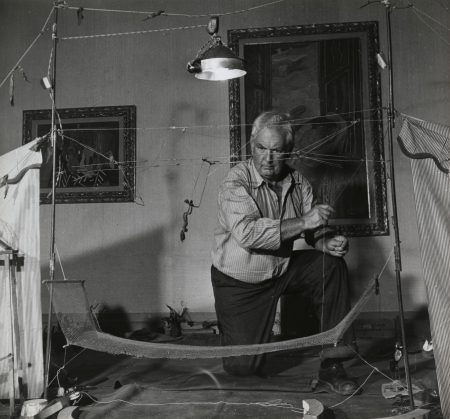
Calder receives a commission for a mobile from Middle East Airlines for their Beirut ticket office.
CF, Salaam to Calder, 30 SeptemberDaughter Sandra goes to live in Paris.
CF, Calder to Peggy, 13 October; Sandra to parents, 18 OctoberBack in Aix-en-Provence, the Calders find another house nearby, Malvalat, which has running water and electricity. Calder sets up a studio on the third floor and continues to concentrate on gouaches.
Calder 1966, 218; MoMA, Calder to Valentin, 2 November
Calder leaves Aix for Paris to begin filming Cirque de Calder, directed by Jean Painlevé.
CF, Calder to mother and the Sterns, 16 NovemberCalder visits Jean and sees his renovated mill house in Saché. Calder agrees to a trade of three mobiles for François Premier, a dilapidated seventeenth-century stone house built adjoining a cliff on Jean’s property.
Calder, 1966, 220–21Calder rigs a studio in Jean’s mill and creates the mobiles. Through the winter, Jean organizes the renovation of François Premier and converts the wagon shed into a studio. A second small building across the street serves as the “gouacherie,” a painting studio.
Calder 1966, 219–20; CF, Calder to mother and the Sterns, 16 NovemberCalder plans a trip to Beirut to visit his friend Henri Seyrig and to make the mobile commissioned by Middle East Airlines.
Calder 1966, 222; CF, Calder to mother and the Sterns, 16 NovemberMuseu de Arte Moderna, São Paulo, Brazil, presents the II Bienal. United States representation consists of three exhibitions prepared by the Museum of Modern Art, New York: two group shows and a solo show devoted to works by Calder.
CF, exhibition file
1954
The Calder family travels on the Greek steamship Aurelia from Marseilles to Greece, where they spend the day in Athens.
CF, passport; Calder 1966, 222The Calders stop in Alexandria, Egypt.
CF, passportThe Calders arrive in Beirut after a stop in Limassol, Cyprus. They reside with the Seyrigs for a month, visiting Syria and Jordan by car.
CF, passport; Calder 1966, 226Calder is given a room to serve as a studio in the Middle East Airlines ticket office, which is under construction.
Calder 1966, 226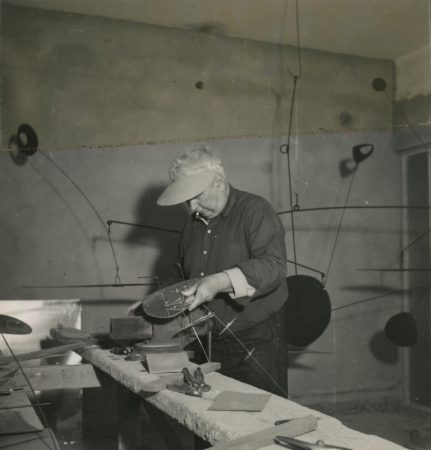
American University, Beirut, exhibits works Calder made during the last month.
CF, exhibition fileThe Calder family visits Jerusalem and Bethlehem.
CF, passport; CF, Calder to mother, 9 FebruaryThe Calders leave Beirut by plane and return to Aix.
CF, passport; Calder 1966, 227Calder leaves Paris, traveling through Amsterdam to Hanover, where an exhibition of his work is scheduled to open at the Kestnergesellschaft.
CF, passportKestnergesellschaft exhibits “Alexander Calder: Stabiles, Mobiles, Gouaches.”
CF, exhibition fileCalder returns to Paris.
CF, passportLouisa and daughter Mary sail from Le Havre to New York.
CF, passportCalder flies from Paris to New York; daughter Sandra remains in France.
CF, passport; Calder 1966, 231The renovation of François Premier is completed.
CF, Davidson to Calder, 24 July